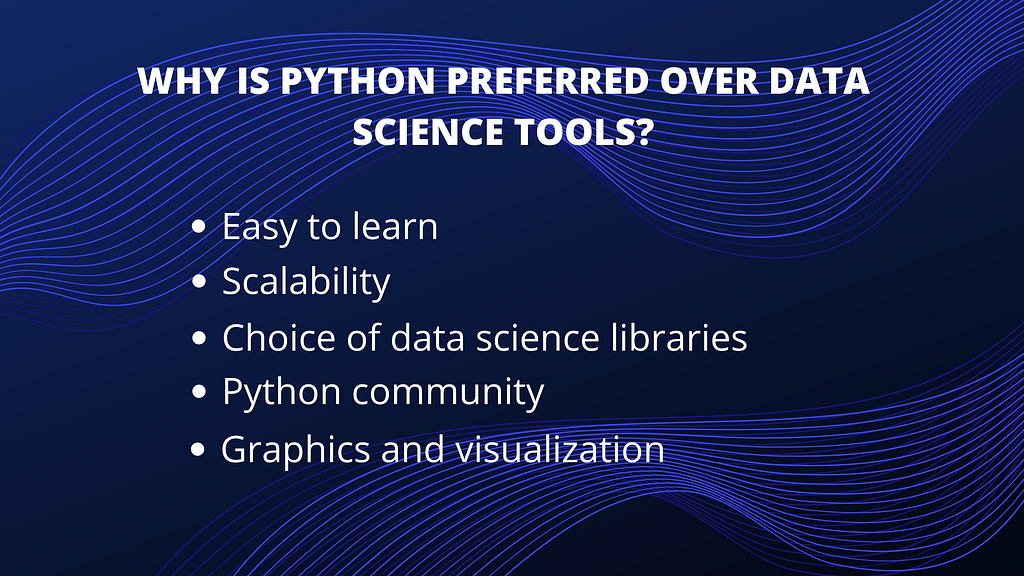
Why is Python so popular among Data Scientists?
Last Updated on October 10, 2020 by Editorial Team
Author(s): Maruti Techlabs
Data Science
Why is Python so Popular Among Data Scientists?
Your organization is only as smart as the data you have access to.

The ability to extract insights from massive amounts of data decides your enterprise’s success. This is where data scientists and analysts interpret data and derive insights to help identify opportunities and make strategic decisions.
For effective analysis of data, data scientists need to be equipped with the best tools for analyzing, reporting, and visualization. Languages such as C, C++, Java and Javascript help understand data. But popular languages like R and Python offer unmatched value in bringing data science and machine learning jobs to successful completion.
Which Is The Most Popular Programming Language In Data Science?
That’s a tricky question to answer. With more languages providing the much-needed option to execute data science jobs, it is not an easy task to handpick a specific language. But it is data that gives a peep into languages that are making headway in the data science world — nothing can be as compelling as the data unveiling results related to the comparison of data science tools. As per a poll by KDnuggets on top analytics/data science tools, R still topped the list of tools. But what stood out was the percentage of change in the share of Python compared to the previous year.
Python’s increase in the share over 2015 rose by 51% demonstrating its influence as a popular data science tool.
Python Emerging As The Leader
There’s battle out there happening in the minds of aspiring data scientists to choose the best data science tool. Though there are quite a number of data science tools that provide the much-needed option, the close combat narrows down between two popular languages — Python and R.
Between R and Python, the latter is emerging as the popular language used more in data science applications.
Take the case of the tech giant Google that has created a deep learning framework called TensorFlow — Python is the primary language used for creating this framework. Its footprint has continued to increase in the environment promoted by Netflix. Production engineers at Facebook and Khan Academy have for long been using it as a prominent language in their environment.
Python has other advantages that speed up it’s an upward swing to the top of data science tools. It integrates well with the most cloud as well as platform-as-a-service providers. In supporting multiprocessing for parallel computing, it brings the distinct advantage of ensuring large-scale performance in data science and machine learning. Python can also be extended with modules written in C/C++.
Where Python Becomes The Perfect-Fit
There are tailor-made situations where it is the best data science tool for the job. It is perfect when data analysis tasks involve integration with web apps or when there is a need to incorporate statistical code into the production database. The full-fledged programming nature of Python makes it a perfect fit for implementing algorithms.
Its packages rooted for specific data science jobs. Packages like NumPy, SciPy, and pandas produce good results for data analysis jobs. While there is a need for graphics, Python’s matplotlib emerges as a good package, and for machine learning tasks, scikit-learn becomes the ideal alternate.
Why Is Python Preferred Over Other Data Science Tools?
It is ‘Pythonic’ when the code is written in a fluent and natural style. Apart from that, it is also known for other features that have captured the imaginations of the data science community.

- Easy to learn
The most alluring factor of Python is that anyone aspiring to learn this language can learn it easily and quickly. When compared to other data science languages like R, Python promotes a shorter learning curve and scores over others by promoting an easy-to-understand syntax.
- Scalability
When compared to other languages like R, Python has established a lead by emerging as a scalable language, and it is faster than other languages like Matlab and Stata. Python’s scalability lies in the flexibility that it gives to solve problems, as in the case of YouTube that migrated to Python. Python has come good for different usages in different industries and for the rapid development of applications of all kinds.
- Choice of data science libraries
The significant factor giving the push for Python is the variety of data science/data analytics libraries made available for the aspirants. Pandas, StatsModels, NumPy, SciPy, and Scikit-Learn, are some of the libraries well known in the data science community. Python does not stop with that as libraries have been growing over time. What you thought was a constraint a year ago would be addressed well by Python with a robust solution addressing problems of a specific nature.
- Python community
One of the reasons for the phenomenal rise of Python is attributed to its ecosystem. As Python extends its reach to the data science community, more and more volunteers are creating data science libraries. This, in turn, has led the way for creating the most modern tools and processing in Python.
The widespread and involved community promotes easy access for aspirants who want to find solutions to their coding problems. Whatever queries you need, it is a click or a Google search away. Enthusiasts can also find access to professionals on Codementor and Stack Overflow to find the right answers for their queries.
- Graphics and visualization
Python comes with varied visualization options. Matplotlib provides a solid foundation around which other libraries like Seaborn, pandas plotting, and ggplot have been built. The visualization packages help you get a good sense of data, create charts, graphical plots, and create web-ready interactive plots.
Is Python ‘THE’ Tool For Machine Learning?
When it comes to data science, machine learning is one of the significant elements used to maximize value from data. With Python as the data science tool, exploring the basics of machine learning becomes easy and effective. In a nutshell, machine learning is more about statistics, mathematical optimization, and probability. It has become the most preferred machine learning tool in the way it allows aspirants to ‘do maths’ easily.
Read also Top 12 Trends Shaping Mobile Application Development in 2020
Name any math function, and you have a Python package meeting the requirement. There is Numpy for numerical linear algebra, CVXOPT for convex optimization, Scipy for general scientific computing, SymPy for symbolic algebra, PYMC3, and Statsmodel for statistical modeling.
With the grip on the basics of machine learning algorithms including logistic regression and linear regression, it makes it easy to implement machine learning systems for predictions by way of its scikit-learn library. It’s easy to customize for neural networks and deep learning with libraries including Keras, Theano, and TensorFlow.
The data science landscape is changing rapidly, and tools used for extracting value from data science have also grown in numbers. The two most popular languages that fight for the top spot are R and Python.
Both are revered by enthusiasts, and both come with their strengths and weaknesses. But with the tech giants like Google showing the way to use Python and with the learning curve made short and easy, it inches ahead to become the most popular language in the data science world.
Why is Python so popular among Data Scientists? was originally published in Towards AI — Multidisciplinary Science Journal on Medium, where people are continuing the conversation by highlighting and responding to this story.
Published via Towards AI
Take our 90+ lesson From Beginner to Advanced LLM Developer Certification: From choosing a project to deploying a working product this is the most comprehensive and practical LLM course out there!
Towards AI has published Building LLMs for Production—our 470+ page guide to mastering LLMs with practical projects and expert insights!

Discover Your Dream AI Career at Towards AI Jobs
Towards AI has built a jobs board tailored specifically to Machine Learning and Data Science Jobs and Skills. Our software searches for live AI jobs each hour, labels and categorises them and makes them easily searchable. Explore over 40,000 live jobs today with Towards AI Jobs!
Note: Content contains the views of the contributing authors and not Towards AI.















